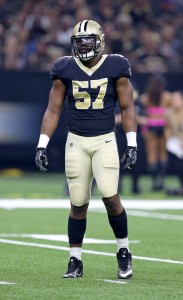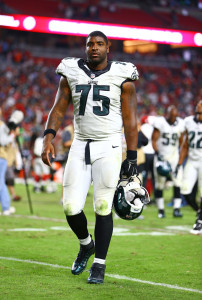In advance of March 14, the start of free agency in the NFL, Pro Football Rumors will detail each team’s three most glaring roster issues. We’ll continue this year’s series with the New Orleans Saints, who finished with an 11-5 record before suffering a devastating loss to the Vikings in the Divisional Round.
Depth Chart (via Roster Resource)
Pending Free Agents:
- Jack Allen, C (ERFA)
- Delvin Breaux, CB (RFA)
- Drew Brees, QB
- Rafael Bush, S
- Brandon Coleman, WR (RFA)
- Chase Daniel, QB
- Kasim Edebali, DE
- Jonathan Freeny, LB
- Clay Harbor, TE
- Gerald Hodges, LB
- John Hughes, DT
- George Johnson, DE
- Senio Kelemete, OL
- John Kuhn, FB
- Josh LeRibeus, OL
- Zach Line, FB
- Michael Mauti, LB
- Tony McDaniel, DT
- Sterling Moore, CB
- Alex Okafor, DE
- David Parry, DT (RFA)
- Willie Snead, WR (RFA)
- Kenny Vaccaro, S
- Zach Wood, LS (ERFA)
Top 10 Cap Hits for 2018:
- Cameron Jordan, DE: $14,247,000
- Terron Armstead, T: $13,500,000
- Larry Warford, G: $9,000,000
- Max Unger, C: $8,000,000
- Coby Fleener, TE: $8,000,000
- Mark Ingram, RB: $6,245,000
- Drew Brees, QB: $6,000,000 (dead money)
- Nick Fairley, DT: $6,000,000 (dead money)
- A.J. Klein, LB: $5,200,000
- Thomas Morstead, P: $4,850,000
Other:
- Projected cap space (via Over the Cap): $31,065,354
- 27th pick in draft
- Must exercise or decline 2019 fifth-year option for G Andrus Peat
Three Needs:
1) Re-sign Drew Brees: The entire Saints’ offseason hinges on re-signing 39-year-old quarterback Drew Brees. Nearly every report has indicated Brees wants to return to New Orleans, and it’s frankly difficult to imagine him leaving for another club. General manager Mickey Loomis & Co. had planned meet with Brees and his representatives at the scouting combine over the next week, and Brees’ unique contract structure means the two sides must agree to a new deal before the 2018 league year begins on March 14.
Brees worked out a one-year extension in September 2016 that locked him up through the 2017 campaign. Technically, the pact runs through the 2020 season, but the typically cap-strapped Saints used three void years in order to spread out Brees’ $30MM signing bonus. Signing bonuses prorate on NFL salary caps, so tacking on “fake” seasons to the end of a contract allow clubs to save cap space in the present while knowing they’ll have to pay the bill down the line.
Because Brees was given a $30MM signing bonus, the Saints are responsible for a $6MM cap charge ($30MM divided by five years) in each season of the deal. Brees’ contract will void on March 14, and if he hasn’t inked a new agreement at that point, the remaining $18MM in signing bonus proration will immediately accelerate onto New Orleans’ 2018 salary cap. What the Saints need to do, then, is extend Brees for a few more years, which would allow them to once again spread out that remaining $18MM.
If the Saints’ history of salary cap management is any indication, they’ll attempt to kick the can down the road again by signing Brees to a new contract that contains more void seasons. A five-year deal that contains a void provision after year two would allow New Orleans to retain Brees for the time being while giving the team even more wherewithal to spread out his signing bonus. Yes, such a plan would simply force the Saints to address Brees’ deal again in say, 2020, but given that New Orleans is squarely in its contention window, Loomis can afford to sort out any contractual problems when the time comes.
For what it’s worth, there’s little question the Saints need to retain Brees despite his advanced age and the surprisingly large number of quarterback alternatives available this offseason. Brees didn’t post his typically gaudy offensive statistics in 2017, but that was largely by design, as he attempted only 536 pass attempts, his lowest in a full 16-game slate since 2005 (his final year with the Chargers).
New Orleans built an offense that doesn’t have to fully rely on Brees, as the club ranked first in rushing DVOA and second in pressure rate allowed. Buoyed by Mark Ingram, Alvin Kamara, and a strong offensive line, Brees ranked second in passer rating and adjusted net yards per attempt, and third in Football Outsiders‘ DVOA, which measures value on a per-play basis.
2) Back to the drawing board opposite Cameron Jordan: The Saints struck gold in 2017 by inking former Cardinals edge rusher Alex Okafor to a one-year, $3MM deal. After years of trying (and failing) to find a defensive end to play alongside standout Cameron Jordan, New Orleans finally landed Okafor, who graded as Pro Football Focus‘ No. 22 edge defender before going down with a torn Achilles in late November. With Okafor in tow, the Saints ranked sixth in adjusted sack rate, their best showing since 2013, and finished 11th in pressure rate.
Okafor was one of the best one-year signings in the NFL a season ago, and the now 27-year-old has indicated that he’d like to return to New Orleans in 2018. While the Saints could explore a new deal with Okafor, they shouldn’t overpay to do so. Okafor didn’t have much of a market last season, and New Orleans doesn’t need to reward him for a (admittedly solid) 10-game sample. If Okafor is willing to re-sign for the $3MM he landed last year, the Saints should be interested. But given that he’s coming off an Achilles injury (which could limit his explosion and first step going forward), Okafor doesn’t need to be a high priority for New Orleans.
The Saints could also look at other internal options before scouring the free agent market in search of edge defenders. Trey Hendrickson was a third-round draft pick last year, and he offered an adequate performance as a situational rusher during his rookie campaign. On 235 pass-rushing snaps, Hendrickson put up 13 quarterback pressures. If New Orleans believes Hendrickson could advance to a full-time role in 2018, the club may not need to find another defensive end. The Saints also have 2017 sixth-rounder Al-Quadin Muhammad on the roster, but the Rutgers product only played 24 defensive snaps last season.
While New Orleans could certainly target an established veteran such as Julius Peppers, it might make more sense for the team to look for another low-cost option akin to Okafor in 2017. Among the candidates who could be on the Saints’ radar is Jeremiah Attaochu, a former-second round pick who has never been able to flourish with the Chargers. He’s also appeared in only 12 games over the past two seasons while dealing with injuries, so the 25-year-old shouldn’t be too expensive. I wonder if the Saints could also take a look at Marcus Smith, the failed former Eagles first-round pick who spent 2017 with the Seahawks. Neither Smith nor Attaochu should be guaranteed starting jobs, but New Orleans could pair them with Hendrickson and hope one flashes.
Another player acquisition avenue the Saints could consider is the trade market. Robert Quinn was just dealt for fourth- and sixth-round picks, and while there’s no indication New Orleans was in on those talks, Quinn’s price could provide a baseline for other defensive end trade prices. The Eagles are reportedly trying to trade Vinny Curry before releasing him, and the Saints could be a fit, especially if they can reduce Curry’s 2018 $9MM base salary. The 29-year-old Curry is an excellent run defender, and produced pressure despite his low sack total. New Orleans could also offer a mid-round pick for the Jaguars’ Dante Fowler Jr., who has one year and a fifth-year option remaining on his rookie contract but is dealing with legal issues and only played 44% of Jacksonville’s defensive snaps in 2017.
3) Add youthful pass-catchers: The Saints finished sixth in passing DVOA last year, but that doesn’t mean they can’t aim to improve their offensive weaponry this offseason. Michael Thomas has blossomed into a genuine star, but Ted Ginn is entering his age-33 season, Willie Snead was a non-factor in 2017 and is now a restricted free agent, and Brandon Coleman has never been able to perfect his Marques Colston/”big slot” impression. At tight end, Coby Fleener hasn’t lived up to his five-year, $36MM contract, and while he’ll likely remain on New Orleans’ roster after the majority of his 2018 base salary guaranteed last month, the Saints could target upgrades.
While I wouldn’t expect the Saints to go after any high-priced free agents next week, Jordan Matthews could make sense if the club wants to get a new slot receiver. Matthews could essentially serve as a turbo-charged Coleman, as his ability to work at the short-to-intermediate level should mesh well with Brees’ strengths. Matthews is only 25 years old, but given that ended the 2017 season on injured reserve after dealing with knee and ankle injuries, he shouldn’t be too expensive. Other free agent wideouts that may be of interest to New Orleans include Donte Moncrief (Colts), John Brown (Cardinals), or Jaron Brown (Cardinals).
More likely, the Saints will look to add a young wide receiver via the draft, and Daniel Jeremiah of NFL.com sent Texas A&M’s Christian Kirk to New Orleans in his most recent mock draft. Kirk should be an immediate contributor in the slot, according to Dane Brugler and Rob Rang of NFLDraftScout.com, and would also offer return ability. Calvin Ridley‘s stock seems to be slipping at the moment, so it’s not out of the question the Alabama product could fall to pick No. 27, while Courtland Sutton (Southern Methodist) and James Washington (Oklahoma State) could also be in consideration.
At tight end, a reunion with Jimmy Graham would certainly be fascinating. In his final four seasons with the Saints, Graham averaged 89 receptions, 1,099 yards, and 12 touchdowns per year, and while that production came during Graham’s age-25 to age-28 campaigns (he’s now 31), it’s worth considering if he could once again flourish with Brees and head coach Sean Payton. Tyler Eifert is likely the only other free agent tight end New Orleans should consider, and he’s somewhat similar to Graham in that he’s a beast in the red zone. Eifert, of course, has struggled to maintain any semblance of health during his five-year career, but he could be in line for an incentive-based deal that wouldn’t harm the Saints’ salary cap in 2018.
Similar to wide receiver, it’s possible the Saints eschew the free agent market in favor of the draft. The top three tight end prospects are generally understood as Dallas Goedert (South Dakota State), Mark Andrews (Oklahoma), and Hayden Hurst (South Carolina). Mel Kiper Jr. of ESPN.com sent Hurst to New Orleans in his most recent mock draft, noting that Hurst’s advanced rookie age (25) could be a concern for some clubs. Andrews, notably, isn’t a blocker, and Lance Zierlein of NFL.com compared him — in an unfavorable way — to Fleener. Other draftable tight ends of note include Mike Gesicki (Penn State), Ian Thomas (Indiana), and Dalton Schultz (Stanford).
i thought Muhammad played at miami not rutgers?